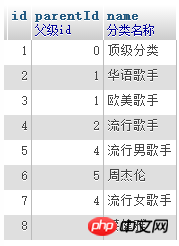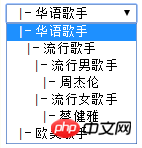 Backend Development
Backend Development
 PHP Tutorial
PHP Tutorial
 Introduction to picture and text code of PHP unlimited classification
Introduction to picture and text code of PHP unlimited classification
Introduction to picture and text code of PHP unlimited classification
Infinite classification means that starting from the highest classification, each sub-category can be divided into several sub-categories of its own, which can be divided all the time, which is called infinite classification;
For example, a tree A tree starts from a trunk and branches off into multiple branches, and these branches branch into other branches. Theoretically, it can be divided indefinitely;
Another example is that a family can have several children. We regard these children as the first level classification. And these children will form their own families. When they have their own offspring, it will be a second-level classification. If each family has more than one child, theoretically it can be divided indefinitely;
In php, the expression of infinite classification is as shown in the figure below;

We use the two fields of id and pid to connect the parent classification and the subset classification, so that You can find the ancestors and their descendants of a certain level of classification, for example, top classification>Chinese singer>Pop singer>Pop male singer>Jay Chou;
Just making data is not enough, we also need To display the data, at this time, we need to use the recursive algorithm of infinite classification.
Here we first explain what recursion is. Recursion is a programming technique in which a function calls itself to achieve the purpose of looping. So the question is, why don't we just use loops? If we use loops directly, we will not be able to solve the problem of parameters very well. Especially when dealing with some complex problems, additional thinking will be required when to initialize parameters and when to accumulate parameters. Not as clear as recursion.
Look at a simple recursion example;
function test(&$b=0){
$b++; if($b<10){
test($b);
} return $b;
}echo test();Recursion is a variant of a loop, so it also needs conditions to break out of the loop, or conditions to continue the loop. The &$b here is a way of passing parameters, which refers to the parameter itself. The parameters passed through & will continue to accumulate;
Return to the previous classification:
$host='127.0.0.1';
$db_user='root';
$db_pass='root';
$db_name='chenbk';
$timezone="Asia/Shanghai";
$link=mysqli_connect($host,$db_user,$db_pass,$db_name);
mysqli_query($link,"SET names UTF8");
header("Content-Type: text/html; charset=utf-8");
function tree($link,&$treeList=array(),$pid = 1,$count = 0) { //$link为数据库连接,&$treeList为输出数组,因为需要累积结果,所以加上引用
$count+=2; //count为识别分级深度的标识
$result = mysqli_query($link,"SELECT * FROM chen_category WHERE parentId={$pid}");
while ($row=mysqli_fetch_assoc($result)) {
$row['count'] = $count;
$row['name'] = str_repeat(' ', $count).'|-'.$row['name']; //通过分级深度的标识,来给分类缩进效果
$treeList[] = $row; //把查询到的结果存储起来
tree($link,$treeList,$row['id'],$count); //再次调用自身,这时的pid为上一条数据的id从而找到上一条数据的子分类;
}
return $treeList; //输出结果
}
$values=tree($link);
echo '<select name="parentId" id="">';
foreach ($values as $key => $value) {
echo '<option value="'.$value['id'].'">'.$value['name'].'</option>';
}
echo '</select>';This function The running process is:
1. Find the highest category through pid=0
2. Add the hierarchical depth to it, add the indentation effect through the hierarchical depth, and then save this data stand up.
3. Call yourself again, passing in the data found in 2. and the id of the first-level classification as the pid of the next-level classification; in this way, every time we find its sub-category, we will finally Find its smallest first-level classification;
The final effect is like this:

I set the default value of pid here to 1, so the highest The classification is not displayed;
As for the sorting effect of this algorithm, it lies in the wilhe loop. When calling the function itself, the first data we found was 2 pieces, one for a Chinese singer and one for a European and American singer. However, , during operation, the function is called hierarchically, just like a multi-layer for loop. It will wait until the innermost loop ends before completing the outer loops in sequence. Therefore, when we found the Chinese singer, the function did not end. The recursion itself found the pop singer. It was not until we found Jay Chou that we started to process the pop female singer on the upper layer. The sorting is completed based on the results of this process.
The above is the detailed content of Introduction to picture and text code of PHP unlimited classification. For more information, please follow other related articles on the PHP Chinese website!

Hot AI Tools

Undresser.AI Undress
AI-powered app for creating realistic nude photos

AI Clothes Remover
Online AI tool for removing clothes from photos.

Undress AI Tool
Undress images for free

Clothoff.io
AI clothes remover

Video Face Swap
Swap faces in any video effortlessly with our completely free AI face swap tool!

Hot Article

Hot Tools

Notepad++7.3.1
Easy-to-use and free code editor

SublimeText3 Chinese version
Chinese version, very easy to use

Zend Studio 13.0.1
Powerful PHP integrated development environment

Dreamweaver CS6
Visual web development tools

SublimeText3 Mac version
God-level code editing software (SublimeText3)

Hot Topics
 1386
1386
 52
52
 PHP 8.4 Installation and Upgrade guide for Ubuntu and Debian
Dec 24, 2024 pm 04:42 PM
PHP 8.4 Installation and Upgrade guide for Ubuntu and Debian
Dec 24, 2024 pm 04:42 PM
PHP 8.4 brings several new features, security improvements, and performance improvements with healthy amounts of feature deprecations and removals. This guide explains how to install PHP 8.4 or upgrade to PHP 8.4 on Ubuntu, Debian, or their derivati
 How To Set Up Visual Studio Code (VS Code) for PHP Development
Dec 20, 2024 am 11:31 AM
How To Set Up Visual Studio Code (VS Code) for PHP Development
Dec 20, 2024 am 11:31 AM
Visual Studio Code, also known as VS Code, is a free source code editor — or integrated development environment (IDE) — available for all major operating systems. With a large collection of extensions for many programming languages, VS Code can be c
 7 PHP Functions I Regret I Didn't Know Before
Nov 13, 2024 am 09:42 AM
7 PHP Functions I Regret I Didn't Know Before
Nov 13, 2024 am 09:42 AM
If you are an experienced PHP developer, you might have the feeling that you’ve been there and done that already.You have developed a significant number of applications, debugged millions of lines of code, and tweaked a bunch of scripts to achieve op
 How do you parse and process HTML/XML in PHP?
Feb 07, 2025 am 11:57 AM
How do you parse and process HTML/XML in PHP?
Feb 07, 2025 am 11:57 AM
This tutorial demonstrates how to efficiently process XML documents using PHP. XML (eXtensible Markup Language) is a versatile text-based markup language designed for both human readability and machine parsing. It's commonly used for data storage an
 Explain JSON Web Tokens (JWT) and their use case in PHP APIs.
Apr 05, 2025 am 12:04 AM
Explain JSON Web Tokens (JWT) and their use case in PHP APIs.
Apr 05, 2025 am 12:04 AM
JWT is an open standard based on JSON, used to securely transmit information between parties, mainly for identity authentication and information exchange. 1. JWT consists of three parts: Header, Payload and Signature. 2. The working principle of JWT includes three steps: generating JWT, verifying JWT and parsing Payload. 3. When using JWT for authentication in PHP, JWT can be generated and verified, and user role and permission information can be included in advanced usage. 4. Common errors include signature verification failure, token expiration, and payload oversized. Debugging skills include using debugging tools and logging. 5. Performance optimization and best practices include using appropriate signature algorithms, setting validity periods reasonably,
 PHP Program to Count Vowels in a String
Feb 07, 2025 pm 12:12 PM
PHP Program to Count Vowels in a String
Feb 07, 2025 pm 12:12 PM
A string is a sequence of characters, including letters, numbers, and symbols. This tutorial will learn how to calculate the number of vowels in a given string in PHP using different methods. The vowels in English are a, e, i, o, u, and they can be uppercase or lowercase. What is a vowel? Vowels are alphabetic characters that represent a specific pronunciation. There are five vowels in English, including uppercase and lowercase: a, e, i, o, u Example 1 Input: String = "Tutorialspoint" Output: 6 explain The vowels in the string "Tutorialspoint" are u, o, i, a, o, i. There are 6 yuan in total
 Explain late static binding in PHP (static::).
Apr 03, 2025 am 12:04 AM
Explain late static binding in PHP (static::).
Apr 03, 2025 am 12:04 AM
Static binding (static::) implements late static binding (LSB) in PHP, allowing calling classes to be referenced in static contexts rather than defining classes. 1) The parsing process is performed at runtime, 2) Look up the call class in the inheritance relationship, 3) It may bring performance overhead.
 What are PHP magic methods (__construct, __destruct, __call, __get, __set, etc.) and provide use cases?
Apr 03, 2025 am 12:03 AM
What are PHP magic methods (__construct, __destruct, __call, __get, __set, etc.) and provide use cases?
Apr 03, 2025 am 12:03 AM
What are the magic methods of PHP? PHP's magic methods include: 1.\_\_construct, used to initialize objects; 2.\_\_destruct, used to clean up resources; 3.\_\_call, handle non-existent method calls; 4.\_\_get, implement dynamic attribute access; 5.\_\_set, implement dynamic attribute settings. These methods are automatically called in certain situations, improving code flexibility and efficiency.



